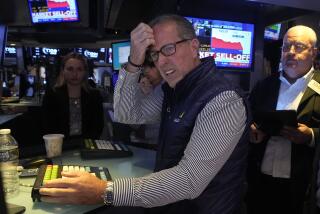The Exuberant May Soon Find Rationality
- Share via
Federal Reserve Chairman Alan Greenspan recently raised the question, “How can we tell when there is irrational exuberance in the financial markets?” The answer, of course, is that in advance of events, we can’t.
But there are three things we can say without equivocation. First, optimism is the natural order in American economic and financial life. After all, for more than eight out of every 10 years, on average, the economy grows, incomes rise, profits expand and financial assets go up in value.
Second, the U.S. equities market has been exceptionally euphoric. The years 1995 and 1996 were the among the best for stock prices in this century. Investors are only human. Success breeds self-confidence and imitation.
Third, whether rationally or irrationally, investors in the market are overlooking or choosing to disregard considerable evidence that stock prices are now very high by historical yardsticks. One eye-opening relationship is the number of hours of work it would take for a worker of median income to buy one unit of the Standard & Poor’s 500 index. That number has soared to nearly 60 hours, double the average since 1960 and four times higher than the bear market trough in 1981. Stocks also are at exceptionally high levels relative to the book values of corporations, and dividend yields are the lowest in 100 years.
Exuberance in the stock market has some genuine economic and financial underpinnings. Interest rates have been moderate. Liquidity has been plentiful. Economic growth has been reasonably good, and inflation has been low and steady. American corporations have undergone profound restructuring, enhancing operational efficiency and lowering costs. They have become competitive in international markets. As a result, corporate cash flows have been expanding apace, and profit margins have improved.
On top of these factors are two structural changes in the marketplace that have accentuated the upward momentum in prices: the astonishing boom in mutual funds and the extraordinary share repurchase programs undertaken by many companies.
The mutual funds phenomenon reflects the confluence of several special developments: Baby boomers are coming into their peak savings years, have higher incomes and have diversified their financial assets more into equities. At the same time, there has been a shift in company pension funds from defined benefit to defined contribution plans. Mutual funds are heavily deployed in 401(k) investments. And mutual fund technology has blossomed, making it easy to shift from one fund to another. Concurrently, interest rates, especially on savings deposits, have not been very rewarding.
But it is hard to believe that the explosion of mutual fund activity would have occurred on a scale that it has if it had not been for the adrenaline of success. The early gains from the stock market rally begot a feeling of invincibility. Who could stand up against the facts? Those who were optimistic about stocks were rewarded handsomely. Those who were dubious or just cautious missed out on historic advances in financial asset values.
Meanwhile, companies have made outstanding profits. They have invested more in plant and equipment, especially computers and other high-tech gear. But they have been able to finance this investment relatively easily through greater cash flow, enhanced by lower borrowing costs, and still have money left over. Do they return the money to shareholders through higher dividends or repay debt? Or do they buy back shares, thereby pushing up further the value of the company’s stock? With the compensation of so many top executives linked to stock prices, the temptation to drive up the stock’s value is overwhelming. Shareholders aren’t likely to complain; after all, capital gains, even after taxes, are generally worth more than cash dividends. Nor are the company’s creditors displeased. They judge that the company can always issue new shares in the future to survive a rainy day.
Consequently, we have a securities market that is based on a curious blend of reasoned analysis, outsized hopes and at least a little bit of greed. Nothing in economic theory says that the forces at work behind the stock market’s rally can’t persist. With every new record high, however, the lessons of financial history counsel prudence.
For at some point, the economy will begin to press against capacity limits, bottlenecks will appear, the rate of inflation will start to lift, interest rates will move higher and the Federal Reserve will decide to curb liquidity in the financial system. Income growth then will slow, companies will have less cash to buy back their stock and some will face financial difficulty.
Also at some point, professional investors will notice that the ratio of equities to their overall assets has risen dramatically in the past five years (the increase is on the order of 12 percentage points for state and local retirement funds and 15 percentage points for private pension funds). They will react by moving back toward the more conservative asset allocations that they had formally established in less exuberant times but have either ignored or overridden lately. Soon after, the comfortable assertion that the flow of money into mutual funds will last indefinitely will be challenged.
How bad will the market correction then be? No one knows, but it will probably be enough to dampen the spirits of even the most exuberant among us.
More to Read
Inside the business of entertainment
The Wide Shot brings you news, analysis and insights on everything from streaming wars to production — and what it all means for the future.
You may occasionally receive promotional content from the Los Angeles Times.










